What is Data Integration in Business Intelligence? [Full Guide]
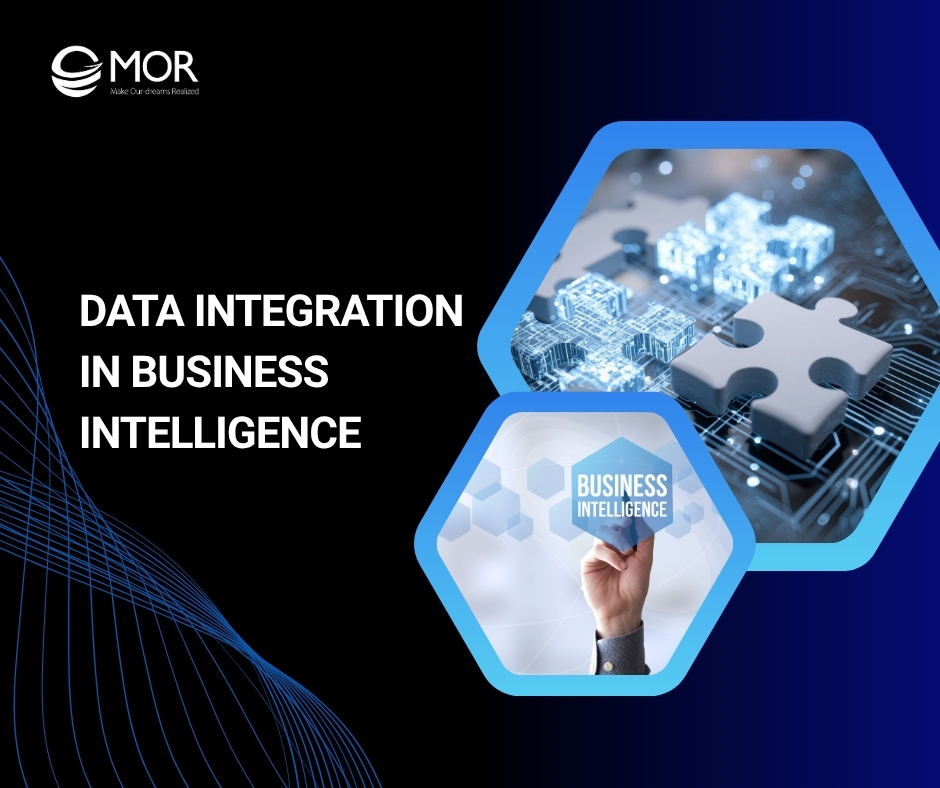
Businesses today generate massive amounts of information, yet struggle to turn it into clear, actionable insights. That’s where data integration in business intelligence comes in, connecting scattered systems into one reliable source of truth. This MOR Software’s guide will explain how integration works, its key benefits, real-world applications, and the best ways to implement it effectively.
What Is Data Integration In Business Intelligence?
Data integration in business intelligence is the process of collecting and combining information from various systems into one consistent and usable format that supports reporting, analytics, and informed decisions. This approach connects information spread across spreadsheets, databases, cloud platforms, and enterprise systems, creating a complete and reliable data foundation for business insight.
In Okta’s 2025 Businesses at Work report, the average company now uses 101 apps. This shows how quickly data becomes fragmented when critical information lives in many tools.
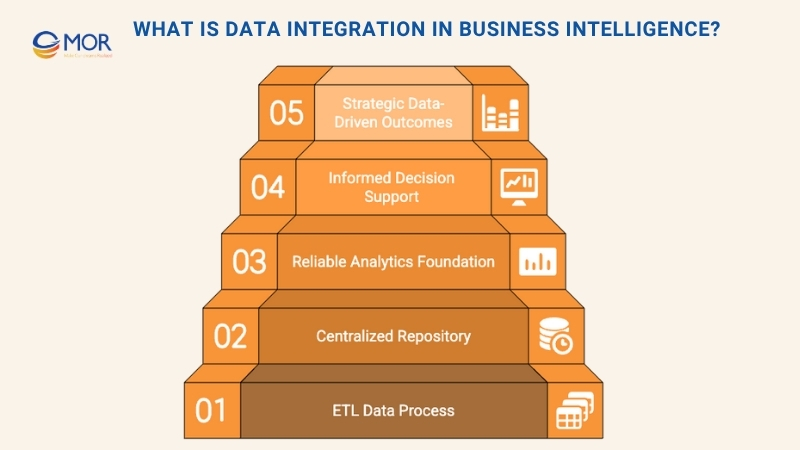
Organisations store information in many places and formats, from CRM software and ERP tools to cloud apps and traditional databases. Each system holds valuable records, but without connection, the data remains fragmented. Through extraction, transformation, and loading steps, often referred to as ETL, the process cleans, standardises, and consolidates data into a single repository like a data warehouse, data lake, or virtual layer. This allows teams to work with accurate, unified data rather than inconsistent, isolated inputs.
Once the process is complete, the integrated dataset becomes a central resource for analytics and reporting. It helps companies:
- Establish one reliable version of the truth across all departments.
- Keep dashboards and BI tools working with accurate and updated information.
- Reveal connections that would otherwise remain hidden, like linking marketing performance with sales outcomes or tracking customer behaviour alongside operational metrics.
Understanding what is data integration in business intelligence highlights how it serves as the backbone of modern analytics. Without this process, systems remain disconnected, and decision-making relies on incomplete data. When properly implemented, it transforms scattered data into a strategic asset that drives collaboration, transparency, and smarter business outcomes.
Why Is Data Integration Important In Business Intelligence?
There are several reasons why data integration in business intelligence plays such a major role in helping organizations gain reliable insights. When executed well, it strengthens collaboration, improves accuracy, and enables leaders to act with confidence. These are the main advantages of data integration in business intelligence that make it indispensable to modern analytics.
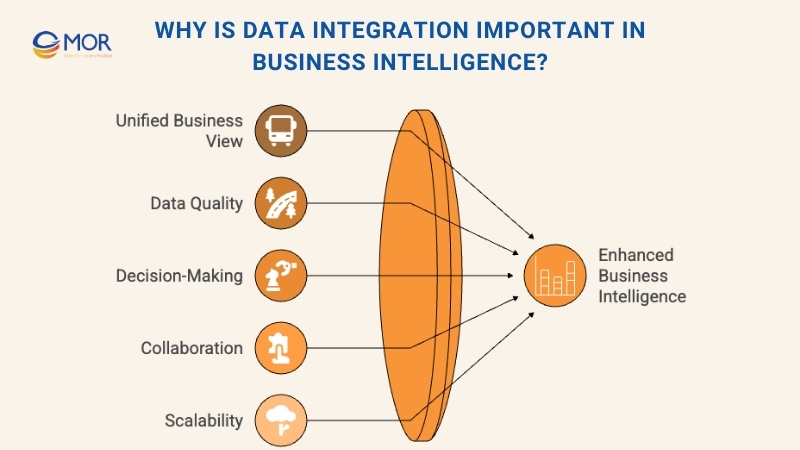
Unified Business View
When information sits separately in disconnected systems, it limits visibility and leads to inconsistent reporting. Integrating data across all sources creates a single, unified view of operations, giving teams a clear picture of how departments and processes connect. This shared visibility allows companies to align goals and measure performance effectively.
Better Data Quality And Consistency
The integration process involves cleaning, validating, and transforming data to ensure accuracy. Gartner estimates that poor data quality costs organisations at least 12.9 million dollars per year on average. This is exactly the kind of avoidable expense that disciplined integration helps reduce.
It eliminates duplication and standardizes formats, which results in more dependable analytics and reports. Reliable data supports confident decision-making, especially when business intelligence platforms rely on information pulled from many systems.
Faster, Smarter Decision-Making
When integrated systems work together, business intelligence tools can process and visualize data faster. Research from MIT CISR finds that companies operating as “real-time” businesses report 62% higher revenue and 97% higher profit margins. This shows how speed to insight converts directly into performance.
This setup supports near real-time analytics, helping teams react quickly to changes in sales, customer behaviour, or market trends. The ability to access accurate insights instantly gives organizations a major edge in fast-moving industries.
Stronger Collaboration And Visibility
Combining data from marketing, operations, finance, and customer service encourages collaboration across departments. A study by Forrester Consulting, commissioned by Airtable, found that decision-makers spend nearly 30% of their week, or about 2.4 hours each day, searching for the right data. Integrated platforms can greatly reduce that time and make teamwork between marketing, operations, finance, and customer service smoother.
Teams can easily trace how one decision affects another, improving communication and accountability. This type of business integration creates a more connected and data-driven culture.
Scalability And Long-Term Growth
As companies expand and adopt new cloud-based systems, integrated platforms make it easier to manage growing volumes of information. These systems provide the flexibility to add new data sources and applications over time without disrupting existing workflows. Experts estimate that the Global DataSphere could reach 175 zettabytes in 2025, showing how important scalable data integration is as data keeps expanding.
Scalable integration keeps analytics efficient and sustainable, even as business needs evolve.
5 Approaches Of Data Integration In Business Intelligence
There are five core methods used to perform data integration in business intelligence: ETL, ELT, data streaming, application integration, and data virtualization. These data integration approaches in business intelligence each serve different business needs depending on the data volume, processing speed, and system environment. Teams can design these pipelines manually using SQL or implement specialized tools that automate data extraction, transformation, and loading to simplify management.
Each of these data integration patterns plays a distinct role in transforming raw information into clean, structured, and analysis-ready data within modern management systems. Together, they provide the foundation that turns disconnected data into valuable business intelligence.
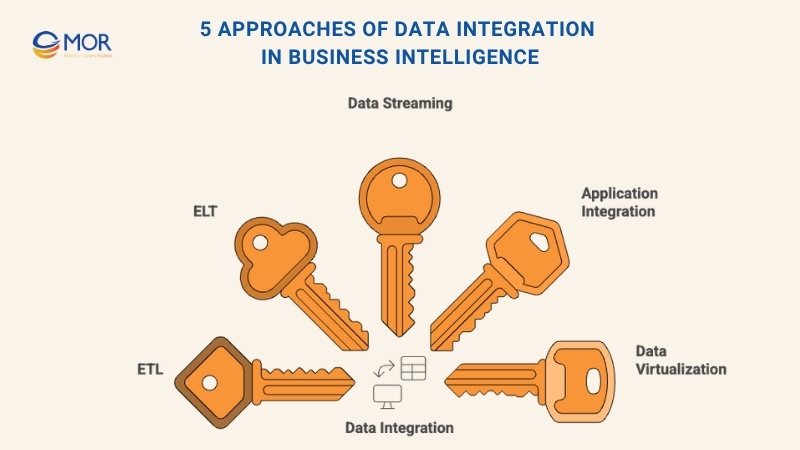
Here are the five main approaches:
1. ETL (Extract, Transform, Load)
ETL is the most traditional and widely used approach for data integration in business intelligence. It involves three main steps: extracting data from source systems, transforming it into a consistent structure, and loading it into a destination repository, such as a data warehouse. In this process, transformation happens in a staging area before data reaches its final location, ensuring that information is accurate and compatible.
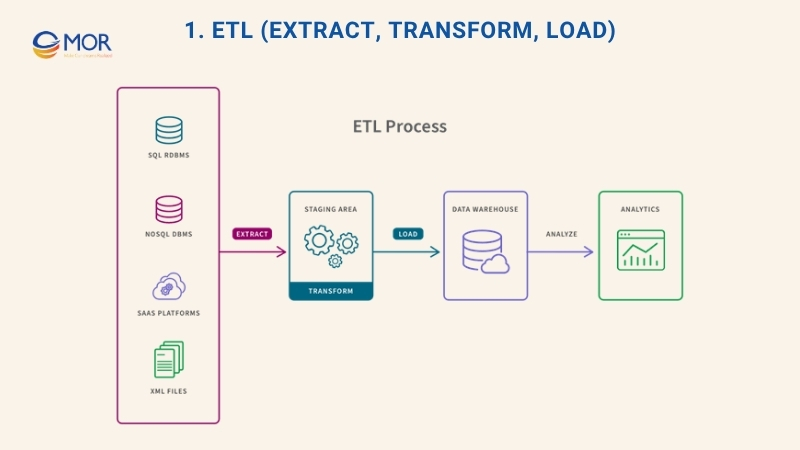
This approach works best for small to medium datasets that need complex restructuring or validation before analysis. ETL pipelines deliver reliable and organized data that supports consistent and trustworthy reporting.
Change Data Capture (CDC) is often used within ETL workflows to identify and record changes made in databases. Tracking updates in real time, it ensures that synchronized systems stay aligned and that business intelligence insights remain timely and accurate.
2. ELT (Extract, Load, Transform)
ELT is a modern variation of data integration in business intelligence that reverses the traditional ETL sequence. In this setup, raw data is first loaded directly into the target system, usually a cloud-based data lake, data warehouse, or data lakehouse, and then transformed within that environment. This approach takes advantage of the processing power of modern cloud platforms, which can handle large datasets more efficiently.
Because transformation occurs after loading, ELT is ideal for organizations dealing with high data volumes or time-sensitive analytics. It supports two main modes: micro-batch and Change Data Capture (CDC). The micro-batch, also called a “delta load,” processes only newly modified records since the last update, while CDC continuously updates the target system as changes happen in real time.
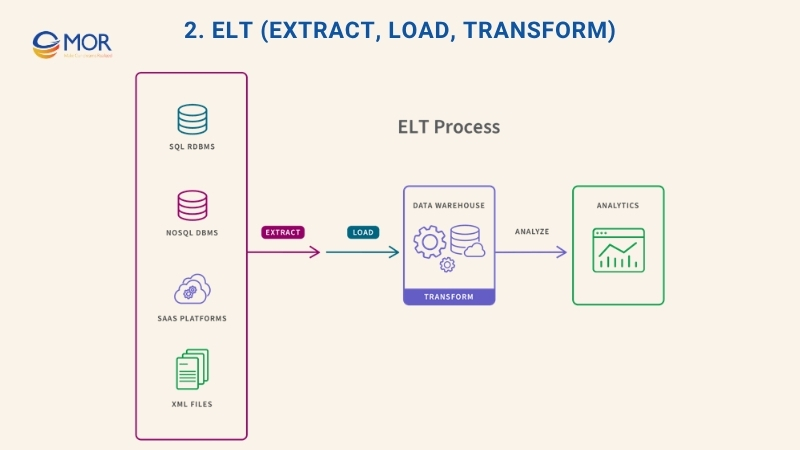
This structure allows teams to maintain current and accurate information with minimal delays, making ELT a preferred choice for businesses that rely on speed and scalability in their analytical workflows.
3. Data Streaming
Data streaming takes data integration in business intelligence a step further by moving information continuously, rather than in periodic batches. This real-time process sends data directly from its source to the target system, whether a cloud platform, data lake, or warehouse, without waiting for scheduled loads.
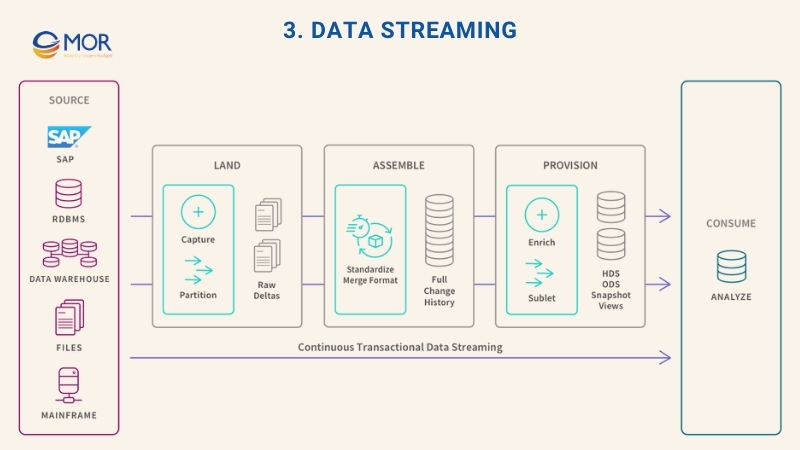
Modern platforms equipped with streaming capabilities can process and deliver analytics-ready data instantly, keeping dashboards and reports constantly updated. This method is especially useful for industries that depend on live insights, such as finance, retail, or logistics, where immediate responses can influence operational and strategic outcomes.
Keeping data in motion, streaming integration eliminates latency and ensures that businesses always work with the most current information available.
4. Application Integration
Application integration uses APIs to connect different software systems so they can exchange and synchronize data smoothly. It’s a key part of integration in business, ensuring that tools like HR analytics tools, accounting, and CRM solutions all operate with the same up-to-date information. This connection eliminates manual data entry, reduces errors, and keeps processes consistent across departments.
Each application usually comes with its own API for sending or receiving data, which can make direct connections complex. To simplify this, many organizations rely on SaaS automation tools that manage these API links efficiently, allowing data to move securely and at scale.

This form of data integration in business intelligence ensures real-time consistency between operational systems, helping teams maintain accuracy, speed, and coordination in their daily workflows.
5. Data Virtualization
Data virtualization works much like streaming but responds only when data is requested by a user or application. Instead of storing copies in a new repository, it creates a single, virtual view that combines information from multiple systems in real time. This method allows users to access consistent, up-to-date data on demand without physically moving it between sources.
Through virtually connecting systems such as CRM, ERP, finance, and logistics, this approach enables seamless analysis and reporting across platforms. It’s especially effective for transactional systems that require high-speed queries and quick responses, helping teams make faster, data-driven decisions.
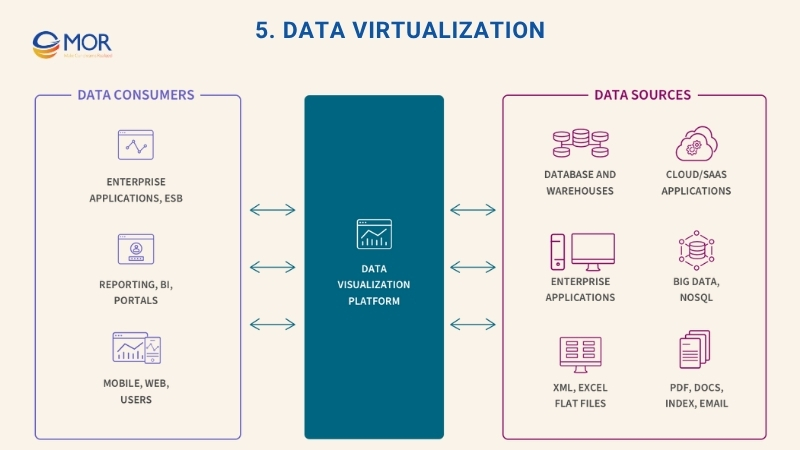
Each of these approaches continues to advance as modern technology evolves. In the past, data warehouses served as the main repository, making the ETL process the standard. That structure still fits smaller, transformation-heavy datasets.
Today, however, new technologies like Integration Platform as a Service (iPaaS), data integration techniques such as data fabric and data mesh, and the growing demand for real-time analytics and machine learning are changing how integration works. The focus is now moving toward ELT, streaming, and API-based solutions that bring agility and scalability to modern data integration in business intelligence.
Use Cases Of Data Integration In Business Intelligence
Data integration in business intelligence supports a variety of goals across industries, helping businesses connect data sources, improve visibility, and make better decisions. Below are several practical use cases that highlight how organizations apply it in their daily operations.
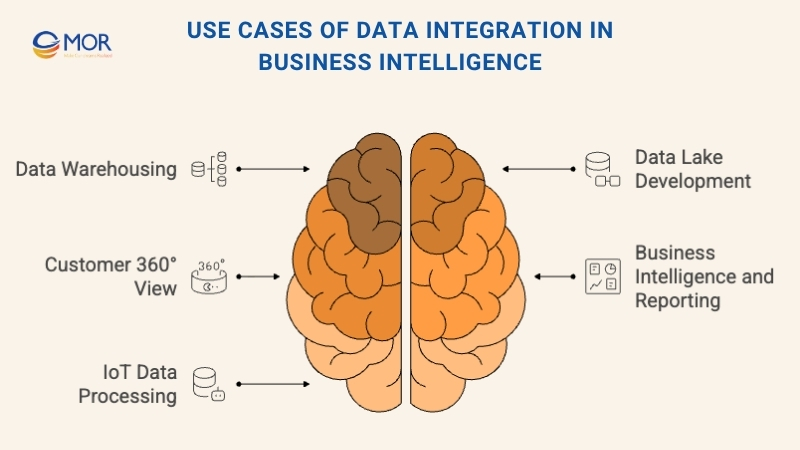
- Data Warehousing: Companies use integration to build centralized data warehouses that store clean, organized data from multiple systems. This unified foundation makes reporting and performance analysis faster and more reliable.
- Data Lake Development: In large-scale environments, structured, unstructured, and semi-structured data often reside in silos. Moving this information into data lakes allows teams to run advanced analytics and machine learning models more efficiently, improving the value extracted from big data.
- Customer 360° View: Combining records from CRM, marketing tools, and support systems enables a complete understanding of each customer. With accurate, integrated data, businesses can refine targeting, identify upselling opportunities, and deliver more personalized service.
- Business Intelligence And Reporting: Integration ensures that dashboards and analytics platforms work with consistent, current information. This connection gives leaders a full picture of business performance across departments such as finance, operations, and sales.
- Processing IoT Data: Merging real-time input from connected devices lets companies monitor equipment, track sensor metrics, and automate workflows based on immediate insights. This makes IoT management smarter and more responsive to live conditions.
Each use case shows how data integration in business intelligence creates a connected data environment that fuels efficiency, accuracy, and strategic growth.
Real-World Examples Of Data Integration In Business Intelligence
Data integration in business intelligence is now a foundation for innovation and informed decision-making across industries. It helps organizations streamline operations, improve accuracy, and unlock the full potential of analytics. Below are several practical examples showing how different sectors use integration to strengthen performance and insight.
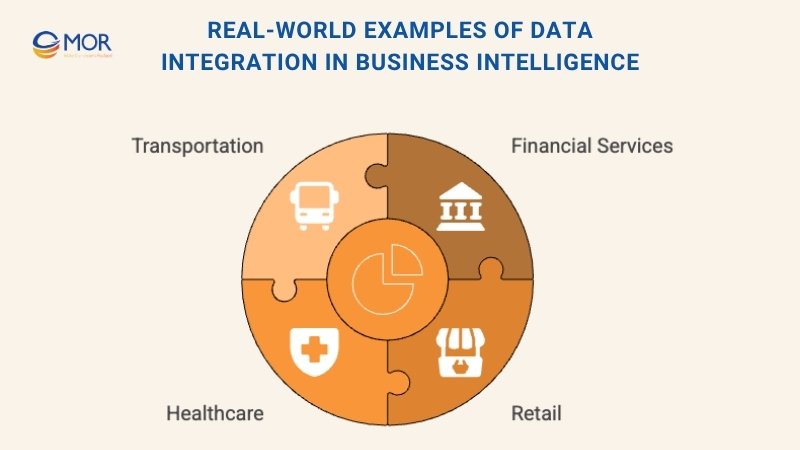
Financial Services
In the financial industry, integration brings together information from various systems, including customer accounts, transaction histories, and risk management tools. By unifying these sources, banks and financial institutions can perform real-time fraud detection, comparing live transactions with past behaviors to flag unusual activities before losses occur.
Integrated data also supports regulatory compliance, allowing firms to meet reporting standards more efficiently. With consistent data feeding into governance and auditing systems, compliance checks become smoother, faster, and more reliable, reducing risk and improving operational transparency.
These data integration examples show how unified data pipelines strengthen trust, security, and accountability in a highly regulated industry.
Retail
In retail, data integration in business intelligence connects information from online stores, physical outlets, customer engagement platforms, and logistics systems. This unified structure gives companies a 360-degree customer view, helping them understand shopping behavior and preferences more accurately.
By combining POS transactions, customer profiles, and even social media insights, retailers can anticipate consumer trends and tailor promotions accordingly. It also helps optimize inventory levels, ensuring the right products are available when and where customers need them, improving both satisfaction and sales performance.
Healthcare
For healthcare organizations, integration connects patient data from hospitals, clinics, laboratories, and external systems into one centralized platform. This enables medical professionals to access a complete medical history instantly, improving diagnosis accuracy and treatment planning.
Beyond individual care, integrated systems help analyze public health trends by linking datasets from different sources. This supports early detection of disease outbreaks, faster intervention, and better coordination across medical and public health institutions, all driven by the power of data integration in business intelligence.
Transportation
In transportation, data integration in business intelligence plays a vital role in managing logistics and large-scale fleet operations. Combining GPS tracking, traffic conditions, and vehicle performance metrics, businesses can optimize delivery routes, reduce fuel usage, and enhance punctuality. These integrations help logistics providers respond quickly to changing road or weather conditions, improving both reliability and cost control.
Airlines and railway companies also rely on integration to process real-time operational data from multiple systems. Analyzing passenger demand, weather forecasts, and schedule data together, they can fine-tune routes, adjust pricing, and allocate resources more effectively.
Across all sectors, this level of connectivity leads to smarter planning, faster decisions, and more personalized services, demonstrating the broad value of data integration in business intelligence in transforming operational performance.
Major Challenges In Data Integration For Business Intelligence
While data integration in business intelligence delivers immense value, it also brings several obstacles that must be managed carefully. Many challenges center on maintaining data quality, connecting disconnected systems, and handling the ever-growing volume and complexity of enterprise data. Addressing these issues is essential to building a consistent, reliable data environment that supports precise analytics and confident decisions.
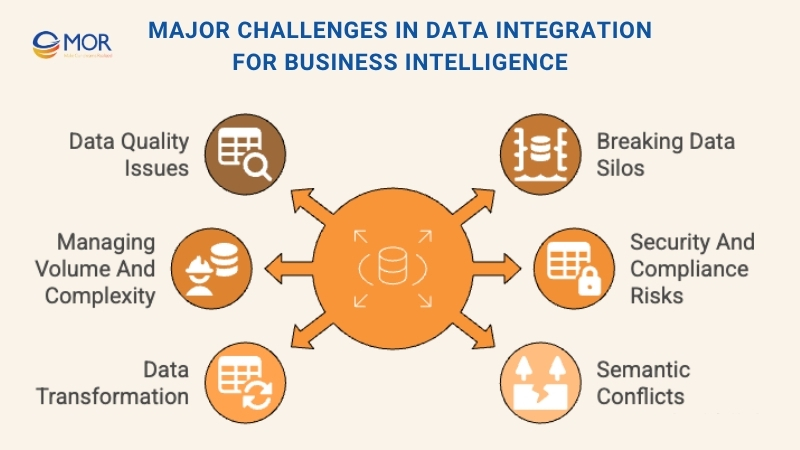
Data Quality Issues
Maintaining high-quality data is one of the toughest parts of any integration effort. Information collected from different systems often varies in format, measurement, or standard, which can lead to inconsistencies once combined.
The larger and more diverse the data sources, the harder it becomes to maintain accuracy. Without proper cleansing and validation, errors can easily slip into reports and dashboards, distorting insights and leading to flawed business conclusions. That’s why continuous monitoring, standardization, and verification are vital steps in every data integration in business intelligence process.
Breaking Down Data Silos
Data silos form when information is stored separately within different systems or departments, creating gaps that make it difficult to gain a complete business view. This fragmentation slows down analytics and limits collaboration across teams. It also complicates governance, as each system may have unique access rules and security requirements.
Overcoming silos in data integration in business intelligence requires coordinated planning, standardized protocols, and strong communication between departments. By connecting systems under a unified architecture, organizations can unlock shared insights and enable more transparent, data-driven decision-making.
Managing Volume And Complexity
Modern businesses collect massive amounts of data every day, from internal databases to customer platforms and IoT devices. Integrating this information effectively is challenging, especially as the mix of structured, semi-structured, and unstructured formats grows.
Scalability and flexibility are crucial for success. Integration platforms must handle expanding workloads while maintaining performance and accuracy. Using advanced automation, metadata management, and adaptive models helps simplify complex processes, allowing data integration in business intelligence to stay efficient even as data environments become larger and more diverse.
Security And Compliance Risks
Security and privacy remain top priorities in data integration in business intelligence, particularly when handling confidential or personally identifiable information. Organizations must comply with strict regulations such as GDPR, CCPA, and HIPAA, ensuring data is collected, stored, and processed responsibly.
Because integration involves multiple systems and transfer points, protecting data from unauthorized access or breaches can be difficult. Strong encryption, access control, and continuous monitoring are essential to keep sensitive information secure throughout the entire integration workflow.
Data Transformation And Schema Mapping
Transforming and aligning data from different sources is one of the most technically demanding parts of integration. Each system may use unique structures, field names, or data types, which must be standardized before analytics can occur.
Accurate schema mapping ensures that information is represented correctly once combined. Any mismatch or inconsistency can distort results and compromise reporting accuracy. Maintaining clear transformation rules and updating them as systems evolve helps guarantee reliable, high-quality outcomes in data integration in business intelligence.
Semantic Conflicts
Semantic integration focuses on resolving meaning-related differences that arise when data from multiple systems or departments uses different definitions for the same concept. In large organizations, this is a common issue that affects the accuracy of data integration in business intelligence.
For instance, two subsidiaries within an airline group might define the term “earning” differently in their databases. Even within one airline, the word “seat” could refer to total capacity for the engineering team but represent tickets sold for the sales department. These conflicting interpretations create fragmented data models and information silos, making it difficult to achieve a unified, accurate view across the business.
Establishing shared data standards and clear definitions helps eliminate such semantic inconsistencies, ensuring that integrated systems interpret and present data consistently across all departments.
Best Practices For Data Integration In Business Intelligence
Following the right strategies for data integration in business intelligence helps organizations bring together data effectively, maintain accuracy, and turn information into meaningful insights. When applying these proven methods, businesses can strengthen the performance, reliability, and long-term value of their BI initiatives.

Establish Clear Business Objectives
Before implementing any integration or BI solution, define goals that align with overall business priorities. Identify what success looks like, whether it’s improving efficiency, boosting revenue, or enhancing customer engagement. Clear KPIs guide the integration design, ensuring that systems and workflows deliver measurable results and real business value.
Select Reliable Data Sources
Integrating data starts with choosing sources that truly support decision-making. Focus on high-quality systems such as CRM, ERP, finance, and external market feeds that provide accurate and relevant information. Avoid unnecessary or redundant data inputs that may slow processing or cloud analysis. Thoughtful selection guarantees cleaner datasets and a more complete understanding of business performance, forming the basis for effective data integration techniques in modern BI environments.
Maintain Data Quality And Consistency
Strong data quality underpins every successful data integration in business intelligence project. Before merging datasets, establish clear procedures for cleaning and validating information to remove duplicates, inconsistencies, and outdated records. Regular audits of data sources help maintain accuracy, completeness, and timeliness. Using automated profiling tools during integration ensures that only reliable information enters BI systems, leading to more trustworthy analytics and confident decision-making.
Use A Scalable Integration Platform
As data volumes expand, integration systems must handle larger workloads without slowing performance. Choosing a scalable cloud-based or hybrid platform allows organizations to adapt to growth and evolving data demands. These modern solutions offer flexibility and elasticity, making it easier to process complex workflows and support continuous business intelligence operations as the organization grows.
Build Strong ETL (Extract, Transform, Load) Processes
A well-structured ETL workflow remains one of the most important data integration techniques for preparing information for analysis. This process extracts data from multiple systems, transforms it into a standardized, usable format, and loads it into a centralized warehouse or lake. Automating ETL ensures real-time updates, minimizes manual errors, and improves overall efficiency, creating a dependable foundation for accurate reporting and faster decision-making in data integration in business intelligence.
Maintain Data Governance And Security
Strong governance and protection practices are essential in data integration in business intelligence. Establish clear policies for how data is accessed, shared, and used across the organization. Compliance with standards such as GDPR and HIPAA must be prioritized, especially when handling sensitive or personal information. Safeguards like encryption, user authentication, and strict access control maintain integrity and privacy, ensuring that all data is managed responsibly and securely within the integration framework.
Centralize Data In Warehouses Or Lakes
Centralized storage remains a core part of integration strategy. Data warehouses handle structured information, while data lakes can accommodate both structured and unstructured formats. Selecting the right model depends on business goals and reporting needs. When properly designed, these repositories allow BI tools to access unified data quickly, supporting accurate real-time analysis and consistent performance.
Apply Data Virtualization
Among modern data integration techniques, data virtualization stands out for its ability to provide instant access to multiple sources without physically moving data. BI systems can query diverse systems simultaneously, reducing duplication and improving efficiency. This method ensures that users always work with the most up-to-date information while keeping integration lightweight and flexible.
Prioritize Data Visualization And Dashboards
The true value of data integration in business intelligence lies in how insights are presented. Interactive dashboards and visual reports turn complex information into clear, actionable insights. Focus on designing visualizations that are intuitive and adaptable, allowing each department to track relevant KPIs and goals easily. Well-crafted visuals bridge the gap between raw data and business understanding, helping teams make faster, smarter decisions.
Enable Self-Service Business Intelligence
Empowering teams with self-service tools is a key step in data integration in business intelligence. Giving employees access to intuitive dashboards and analytics platforms, they can explore data, generate reports, and uncover insights without depending on IT. Providing proper training and user-friendly BI software encourages data literacy across departments and supports faster, evidence-based decision-making.
Monitor And Optimize Performance
Consistent performance monitoring keeps integration and BI systems efficient. Track metrics such as data processing times, query speeds, and dashboard load performance to detect slowdowns or inefficiencies. Regular optimization, through refining data flows, updating ETL pipelines, or improving infrastructure, ensures that systems remain responsive and reliable as data volumes grow.
Foster Cross-Department Collaboration
Successful business integration depends on communication between teams. Encouraging collaboration among sales, marketing, finance, and operations ensures that all perspectives are represented in analytics and reporting. When departments share data and agree on consistent metrics, the organization gains a more accurate and holistic view of performance.
Regularly Review And Update Your Strategy
Technology and business needs change quickly, so BI strategies must evolve in response. Periodic reviews of tools, data sources, and workflows keep systems aligned with company goals. Updating processes also helps maintain compatibility with emerging data integration techniques, ensuring that insights stay accurate and actionable.
Promote A Data-Driven Culture
A strong data-driven culture ensures that analytics becomes part of daily decision-making. Encourage leaders and employees to rely on facts rather than intuition, and provide ongoing education so teams know how to interpret and apply insights effectively.
When these practices are applied together, organizations gain more value from their data integration in business intelligence efforts, resulting in better decisions, higher efficiency, and long-term competitive strength.
MOR Software: Your Partner In Data Integration Success
At MOR Software JSC, we help organizations turn scattered data into a single, reliable foundation for smarter decisions. With over 850 completed projects across 10+ countries, our team delivers tailored data integration solutions that align with your BI goals and business structure.
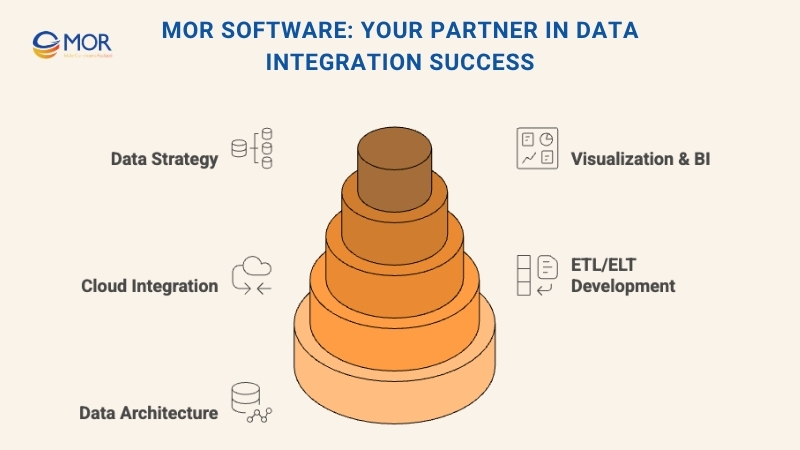
We combine technical depth with strategic insight to design systems that connect, clean, and visualize your data efficiently. Our services cover every stage of the process:
- Data Architecture Consulting: We assess your current systems and define the best integration model for long-term scalability.
- Custom ETL/ELT Development: Our engineers build robust pipelines that keep your data consistent and analytics-ready.
- Cloud and API Integration: We connect on-premise and cloud systems securely to streamline data exchange across your ecosystem.
- Visualization and BI Enablement: Our developers create intuitive dashboards that turn complex information into actionable intelligence.
With MOR, businesses gain a trusted partner who ensures their data integration in business intelligence strategy drives measurable growth and reliable insights.
Conclusion
Effective data integration in business intelligence helps organizations transform raw information into strategic insights that drive smarter decisions. From unified systems to real-time analytics, it strengthens every part of modern business operations. With MOR Software’s expertise, companies can build scalable, secure, and insight-driven data ecosystems that deliver long-term value. Ready to take your analytics to the next level? Contact MOR Software today to start building your custom data integration solution.
MOR SOFTWARE
Frequently Asked Questions (FAQs)
Why is data integration important for business intelligence systems?
It ensures all departments use consistent, accurate, and up-to-date data, allowing decision-makers to base insights on a single source of truth.
What does data integration mean in business intelligence?
Data integration in business intelligence is the process of collecting, transforming, and combining data from different sources into a unified format that supports analysis and reporting.
What are the main techniques used in data integration?
Common approaches include ETL (Extract, Transform, Load), ELT (Extract, Load, Transform), real-time data streaming, API-based integration, and data virtualization.
How does data integration improve decision-making?
Integrated data removes inconsistencies, enabling faster and more confident decisions based on comprehensive, accurate insights across the organization.
What tools are often used for data integration in BI?
Popular tools include Talend, Informatica, Microsoft Azure Data Factory, IBM DataStage, Qlik Data Integration, and Apache NiFi.
What challenges do companies face with data integration?
Key challenges include poor data quality, fragmented systems, large data volumes, incompatible formats, and maintaining data security during transfers.
What is the difference between ETL and ELT?
ETL transforms data before loading it into the warehouse, while ELT loads data first and transforms it afterward within the target system.
How does data integration support real-time analytics?
Through streaming and API-based integration, businesses can continuously update dashboards and monitor operations as data changes in real time.
Can small businesses benefit from data integration in business intelligence?
Yes. Even small companies can centralize data from tools like CRM, accounting, and eCommerce platforms to uncover valuable performance insights.
How is cloud technology changing data integration?
Cloud-based data integration platforms allow faster processing, easier scalability, and seamless connection between on-premise and cloud applications.
Rate this article
0
over 5.0 based on 0 reviews
Your rating on this news:
Name
*Email
*Write your comment
*Send your comment
1